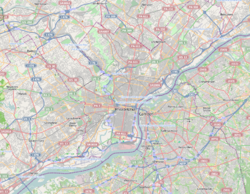St. Mark's Episcopal Church (Philadelphia, Pennsylvania)
|
Saint Mark's Episcopal Church
|
|

Saint Mark's Episcopal Church in 2010
|
|
| Location | 1607-27 Locust St., Philadelphia, Pennsylvania |
|---|---|
| Coordinates | 39°56′56″N 75°10′7″W / 39.94889°N 75.16861°WCoordinates: 39°56′56″N 75°10′7″W / 39.94889°N 75.16861°W |
| Built | 1848 |
| Architect |
John Notman Cope and Stewardson |
| Architectural style | Gothic Revival |
| NRHP Reference # | 82003815 |
| Significant dates | |
| Added to NRHP | April 19, 1982 |
| Designated NHL | February 4, 1985 |
Saint Mark's Episcopal Church, Philadelphia, at 1625 Locust St, Center City, Philadelphia, Pennsylvania, is an Episcopal church in the Anglo-Catholic tradition. It is part of the Diocese of Pennsylvania.
The church was founded in the mid-19th Century as part of the Tractarian Oxford Movement revival in the Anglican Church. The building was built by John Notman in the Gothic Revival style between 1847 and 1849, based on an original design by English architect Richard Cromwell Carpenter. The tower was designed by Notman, and completed in 1865 by George Hewitt. The Main entrance with polychromed figurers depicting "Christ in Majesty" are part of the portal designed by Milton Bennett Medary of the Zantzinger, Borie, and Medary firm in 1923. The Lady Chapel was designed by Cope and Stewardson in the late decorated Gothic style. It was built in 1900; the ceiling is the first known example in the US of a stone vault. Both construction of the chapel and its furnishings were donated by Rodman Wanamaker in memory of his late wife. Because of its architectural quality and significance, the building has been designated a National Historic Landmark (NHL).
The church contains several ornaments by Charles Eamer Kempe; the Lady Chapel was originally decorated entirely according to Kempe's designs. When it was later redecorated, the altar was moved to the head of the north aisle to become the St. John's Altar. The polychromed figures were moved throughout the church, while the original stained glass remains in place. The church also has several Kempe frontals, representing a significant proportion of the surviving embroideries from that firm, some of which are still in occasional use. The Lady Chapel now contains a world-renowned silver altar with nearly 150 individually sculpted saints and scenes from the life of the Virgin Mary. It is humorously said of this altar that it is "The only place where one can worship both God and Mammon at the same time."
...
Wikipedia



